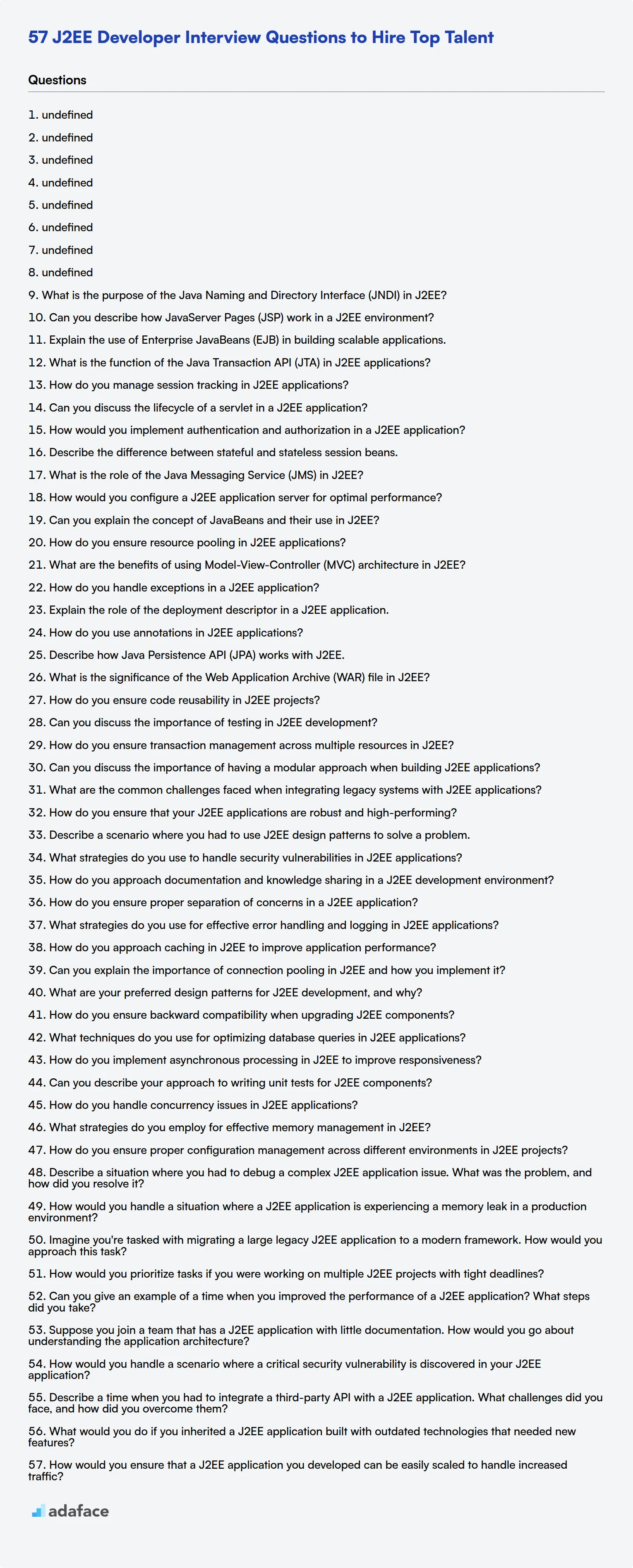Finding the right J2EE Developer for your team can be a daunting task, especially when you're not sure what questions to ask during the interview process. The right set of questions can help you assess a candidate's technical expertise, problem-solving skills, and understanding of enterprise applications.
This blog post provides a comprehensive list of J2EE Developer interview questions, categorized for different experience levels and areas of expertise. We cover general questions, junior developer-specific queries, enterprise application-related inquiries, best practices, and situational questions to help you evaluate top talent.
By using these questions, you'll be better equipped to identify candidates who possess the necessary skills and knowledge for your J2EE development projects. Additionally, consider using a pre-employment assessment to objectively evaluate candidates' J2EE skills before the interview stage.
Table of contents
8 general J2EE Developer interview questions and answers

Ready to find your next stellar J2EE Developer? These 8 general interview questions will help you assess candidates' understanding of core J2EE concepts and their ability to apply them in real-world scenarios. Use this list to gauge both technical knowledge and problem-solving skills, ensuring you find the right fit for your development team.
1. Can you explain the difference between J2EE and Java SE?
J2EE (Java 2 Enterprise Edition) is a set of specifications that extends Java SE (Standard Edition) to provide a complete, stable, secure, and fast Java platform for enterprise-level application development. While Java SE provides the core functionality for Java programming, J2EE adds libraries and features specifically designed for building large-scale, distributed, and multi-tiered applications.
Key differences candidates should mention include:
- J2EE includes additional APIs for database access, remote method invocation, messaging, and web services
- J2EE provides a runtime environment for deploying and managing large-scale applications
- J2EE offers services like security, transaction management, and resource pooling
Look for candidates who can clearly articulate these differences and provide examples of when they would choose J2EE over Java SE for a project. Strong answers will demonstrate an understanding of enterprise-level application requirements and how J2EE addresses them.
2. What are the main components of a J2EE application?
The main components of a J2EE application typically include:
- Client-side components: Web pages, applets, and applications
- Web components: Servlets and JavaServer Pages (JSP)
- Business components: Enterprise JavaBeans (EJB)
- Enterprise Information System (EIS) tier: Databases and legacy systems
Each of these components plays a crucial role in building a robust, scalable J2EE application. The client-side components handle user interaction, web components process requests and generate dynamic content, business components contain the core business logic, and the EIS tier manages data persistence and integration with existing systems.
Look for candidates who can not only list these components but also explain how they interact within a J2EE application. Strong answers will include examples of how these components work together to create a complete enterprise application. Consider asking follow-up questions about specific experiences they've had working with each component.
3. How does J2EE handle database connectivity?
J2EE provides robust database connectivity primarily through JDBC (Java Database Connectivity) and JPA (Java Persistence API). JDBC is a Java API that allows applications to connect to and interact with relational databases, while JPA is a higher-level specification for managing relational data in Java applications.
Key points candidates should mention:
- JDBC provides a standard interface for connecting to databases, executing SQL queries, and managing transactions
- JPA offers an object-relational mapping (ORM) framework, simplifying database operations by allowing developers to work with Java objects instead of SQL statements
- Connection pooling is often used in J2EE applications to efficiently manage database connections
- J2EE containers typically provide built-in support for database connectivity, including connection pooling and distributed transactions
Look for candidates who can explain these concepts clearly and discuss their experiences using them in real-world projects. Strong answers might include comparisons between JDBC and JPA, or discussions about optimizing database performance in J2EE applications. Consider asking about specific challenges they've faced with database connectivity in J2EE and how they overcame them.
4. What is the role of a servlet container in a J2EE application?
A servlet container, also known as a web container, is a crucial component of the J2EE architecture. It provides a runtime environment for managing and executing Java servlets and JavaServer Pages (JSP). The primary responsibilities of a servlet container include:
- Managing the lifecycle of servlets (init, service, and destroy methods)
- Processing client requests and mapping them to the appropriate servlets
- Managing sessions and providing session tracking mechanisms
- Handling concurrency and multi-threading for servlet execution
- Implementing the Servlet API as defined in the J2EE specification
Popular servlet containers include Apache Tomcat, Jetty, and those provided by full J2EE application servers like WebSphere or JBoss.
When evaluating responses, look for candidates who can clearly explain the role of the servlet container and its importance in the J2EE ecosystem. Strong answers might include discussions about the benefits of using a servlet container (such as improved security and resource management) or comparisons between different container implementations. Consider asking follow-up questions about their experience with specific servlet containers or challenges they've faced in configuring and optimizing them.
5. Can you explain the concept of dependency injection in J2EE?
Dependency Injection (DI) is a design pattern and a key feature in J2EE that aims to reduce coupling between software components. It allows the container to 'inject' objects into a class, rather than having the class create and manage these objects itself. This approach promotes loose coupling, improves testability, and enhances the overall flexibility and maintainability of the application.
In J2EE, DI is typically implemented through:
- Constructor injection: Dependencies are provided through a class constructor
- Setter injection: Dependencies are set through setter methods
- Interface injection: The dependency provides an injector method that will inject the dependency into any client passed to it
Frameworks like Spring and Java EE's CDI (Contexts and Dependency Injection) provide robust support for dependency injection. Look for candidates who can explain the benefits of DI, such as easier unit testing and more modular code. Strong answers might include examples of how they've used DI in their projects or discussions about the trade-offs between different injection methods. Consider asking about specific challenges they've faced when implementing DI in large-scale J2EE applications.
6. How does J2EE support scalability in enterprise applications?
J2EE provides several features and architectural patterns that support scalability in enterprise applications:
- Distributed architecture: J2EE applications can be deployed across multiple servers, allowing for horizontal scaling
- Load balancing: J2EE application servers often include built-in load balancing capabilities to distribute traffic across multiple instances
- Clustering: J2EE supports clustering of application servers to improve availability and performance
- Connection pooling: Efficient management of database connections helps applications scale by reducing resource overhead
- Caching: J2EE provides mechanisms for caching frequently accessed data, reducing database load
- Asynchronous processing: Features like JMS (Java Message Service) allow for asynchronous, scalable processing of tasks
Candidates should be able to explain these concepts and how they contribute to building scalable applications. Look for answers that demonstrate an understanding of both vertical scaling (adding more resources to a single server) and horizontal scaling (adding more servers). Strong responses might include real-world examples of how they've implemented these features to improve application scalability. Consider asking follow-up questions about specific challenges they've faced in scaling J2EE applications and how they overcame them.
7. What are some best practices for securing J2EE applications?
Security is a critical aspect of J2EE application development. Some best practices for securing J2EE applications include:
- Implementing authentication and authorization: Use J2EE's built-in security features or frameworks like Spring Security
- Securing communication: Use SSL/TLS for all sensitive data transmission
- Input validation: Validate all user inputs to prevent injection attacks
- Secure session management: Implement proper session handling and timeout mechanisms
- Principle of least privilege: Grant users and components only the minimum necessary permissions
- Regular security audits and updates: Keep all components and libraries up-to-date with the latest security patches
- Secure configuration: Ensure proper configuration of application servers, databases, and other components
- Encryption: Use strong encryption for sensitive data at rest and in transit
Look for candidates who can explain these practices and provide examples of how they've implemented them in real-world projects. Strong answers might include discussions about specific security vulnerabilities they've encountered and how they addressed them. Consider asking follow-up questions about their experience with security frameworks or tools commonly used in J2EE development.
8. How do you approach performance optimization in J2EE applications?
Performance optimization in J2EE applications involves a multi-faceted approach:
- Database optimization: Efficient query design, proper indexing, and connection pooling
- Caching: Implementing application-level caching and utilizing distributed caching solutions
- Code optimization: Writing efficient algorithms and using appropriate data structures
- JVM tuning: Optimizing garbage collection and memory allocation
- Load balancing and clustering: Distributing load across multiple servers
- Asynchronous processing: Using message queues for non-critical, time-consuming tasks
- Minimizing network calls: Reducing the number of remote method invocations
- Proper resource management: Closing connections and releasing resources promptly
Candidates should be able to discuss these strategies and explain how they've applied them in real projects. Look for answers that demonstrate a systematic approach to performance optimization, including profiling, identifying bottlenecks, and measuring improvements. Strong responses might include examples of specific performance issues they've resolved and the tools they used in the process. Consider asking about their experience with performance monitoring and profiling tools commonly used in J2EE environments.
20 J2EE Developer interview questions to ask junior developers
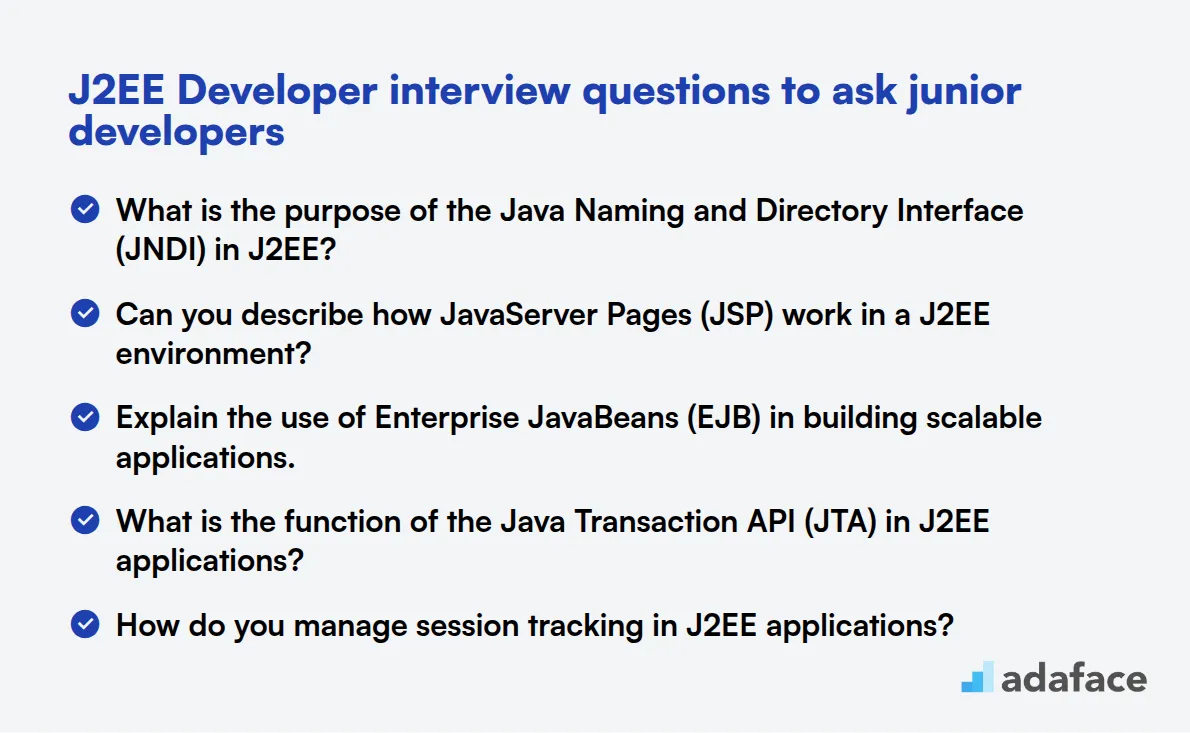
To identify the technical fit of applicants for a J2EE developer role, consider using these interview questions. This list is designed to help you assess whether they possess the necessary foundational skills and understanding to succeed in this dynamic field. For more detailed insights, explore our J2EE Developer job description.
- What is the purpose of the Java Naming and Directory Interface (JNDI) in J2EE?
- Can you describe how JavaServer Pages (JSP) work in a J2EE environment?
- Explain the use of Enterprise JavaBeans (EJB) in building scalable applications.
- What is the function of the Java Transaction API (JTA) in J2EE applications?
- How do you manage session tracking in J2EE applications?
- Can you discuss the lifecycle of a servlet in a J2EE application?
- How would you implement authentication and authorization in a J2EE application?
- Describe the difference between stateful and stateless session beans.
- What is the role of the Java Messaging Service (JMS) in J2EE?
- How would you configure a J2EE application server for optimal performance?
- Can you explain the concept of JavaBeans and their use in J2EE?
- How do you ensure resource pooling in J2EE applications?
- What are the benefits of using Model-View-Controller (MVC) architecture in J2EE?
- How do you handle exceptions in a J2EE application?
- Explain the role of the deployment descriptor in a J2EE application.
- How do you use annotations in J2EE applications?
- Describe how Java Persistence API (JPA) works with J2EE.
- What is the significance of the Web Application Archive (WAR) file in J2EE?
- How do you ensure code reusability in J2EE projects?
- Can you discuss the importance of testing in J2EE development?
7 J2EE Developer interview questions and answers related to enterprise applications
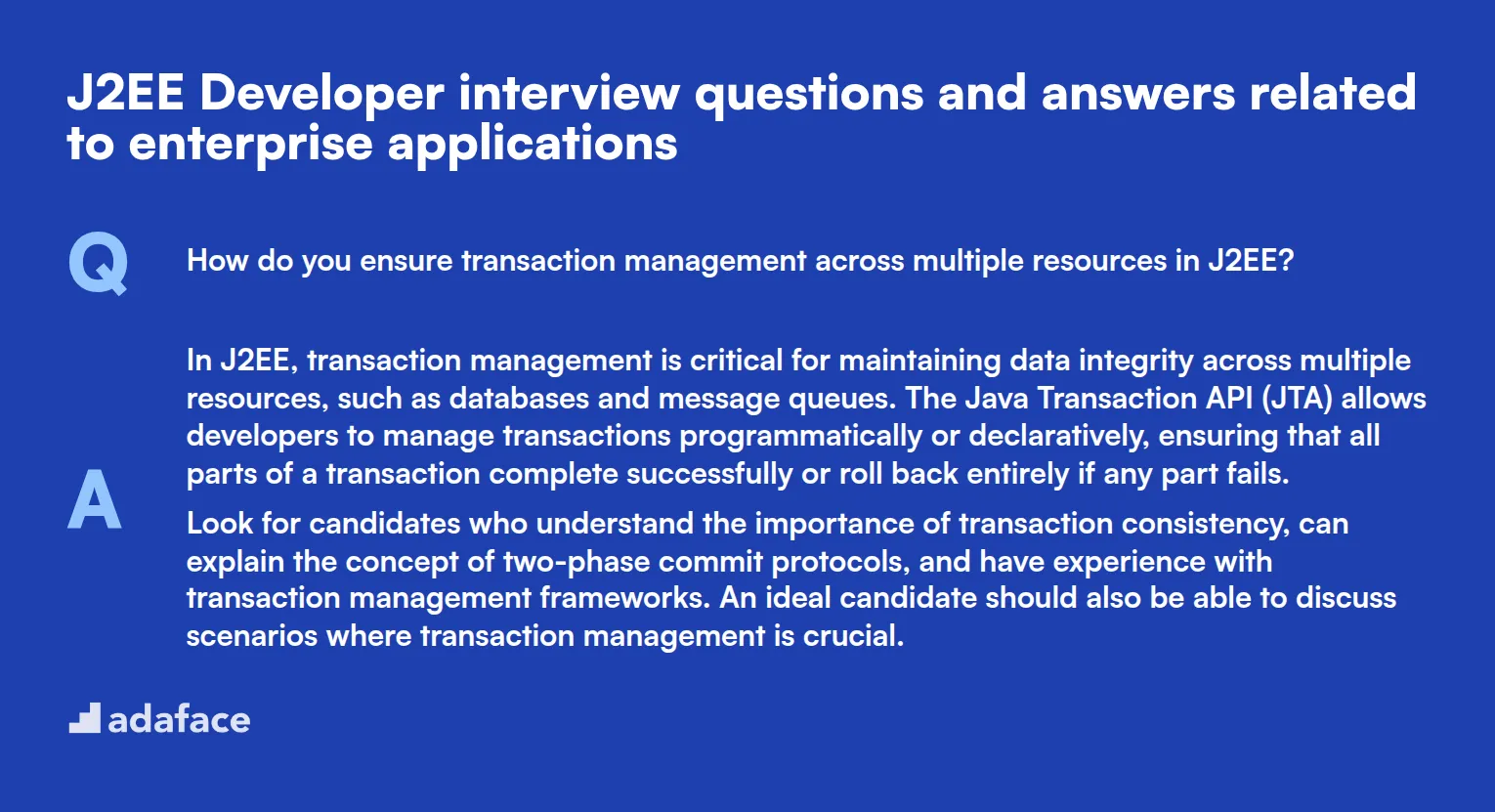
If you're aiming to sift through the technical weeds and find a J2EE developer who can build robust enterprise applications, this list of questions is your treasure map. Use it in interviews to discern not just technical prowess but also holistic understanding of J2EE principles.
1. How do you ensure transaction management across multiple resources in J2EE?
In J2EE, transaction management is critical for maintaining data integrity across multiple resources, such as databases and message queues. The Java Transaction API (JTA) allows developers to manage transactions programmatically or declaratively, ensuring that all parts of a transaction complete successfully or roll back entirely if any part fails.
Look for candidates who understand the importance of transaction consistency, can explain the concept of two-phase commit protocols, and have experience with transaction management frameworks. An ideal candidate should also be able to discuss scenarios where transaction management is crucial.
2. Can you discuss the importance of having a modular approach when building J2EE applications?
A modular approach in J2EE development ensures that applications are scalable, maintainable, and easier to test. By breaking down an application into modules, developers can isolate functionality, making it easier to update or replace parts without affecting the entire system.
Candidates should highlight the benefits of modularity, such as improved collaboration among teams, reusability of code, and better separation of concerns. A strong response would include examples of how they've implemented modular architecture in past projects, possibly referencing skills required for software developer.
3. What are the common challenges faced when integrating legacy systems with J2EE applications?
Integrating legacy systems with J2EE applications often presents challenges such as mismatched data formats, differing communication protocols, and potential performance bottlenecks. These systems may not support modern technologies, requiring the use of middleware or custom adapters.
Ideal candidates will be able to identify these challenges and discuss strategies to overcome them, such as using Enterprise Application Integration (EAI) tools and designing robust middleware solutions. Look for responses that demonstrate problem-solving skills and experience in dealing with complex integration scenarios.
4. How do you ensure that your J2EE applications are robust and high-performing?
Ensuring robustness and high performance in J2EE applications involves careful design and implementation choices. This includes using efficient algorithms, optimizing database queries, and employing caching strategies to reduce load times. Additionally, leveraging performance monitoring tools helps in identifying bottlenecks early.
Candidates should articulate their approach to performance tuning and testing, emphasizing their ability to balance performance with maintainability. An ideal candidate would provide examples of previous projects where they improved application performance and discuss their methodology.
5. Describe a scenario where you had to use J2EE design patterns to solve a problem.
J2EE design patterns offer standardized solutions to common problems in software design. For example, the Model-View-Controller (MVC) pattern is often used to separate business logic from presentation, making applications more modular and easier to maintain.
Candidates should describe a specific scenario where they applied a design pattern, detailing the problem, the pattern used, and the outcome. Look for answers that demonstrate a deep understanding of when and why to use certain patterns, as well as the ability to adapt them to different contexts.
6. What strategies do you use to handle security vulnerabilities in J2EE applications?
Handling security vulnerabilities in J2EE applications involves a multi-layered approach, including input validation, proper authentication and authorization mechanisms, and encryption of sensitive data. Keeping up with the latest security patches and updates is also crucial.
Candidates should discuss their experience with security assessments and mention tools or practices they've used to ensure application security. An ideal answer will show a proactive approach to security, highlighting past experiences where they successfully mitigated vulnerabilities.
7. How do you approach documentation and knowledge sharing in a J2EE development environment?
Effective documentation and knowledge sharing are vital in a J2EE development environment to ensure team alignment and project continuity. This can include maintaining comprehensive API documentation, creating design and architecture diagrams, and holding regular knowledge-sharing sessions.
Candidates should emphasize the importance of clear and accessible documentation, as well as their role in promoting a culture of knowledge sharing within their team. Look for examples where they have contributed to or improved documentation practices, ensuring that team members and stakeholders are well-informed.
12 J2EE Developer questions related to best practices
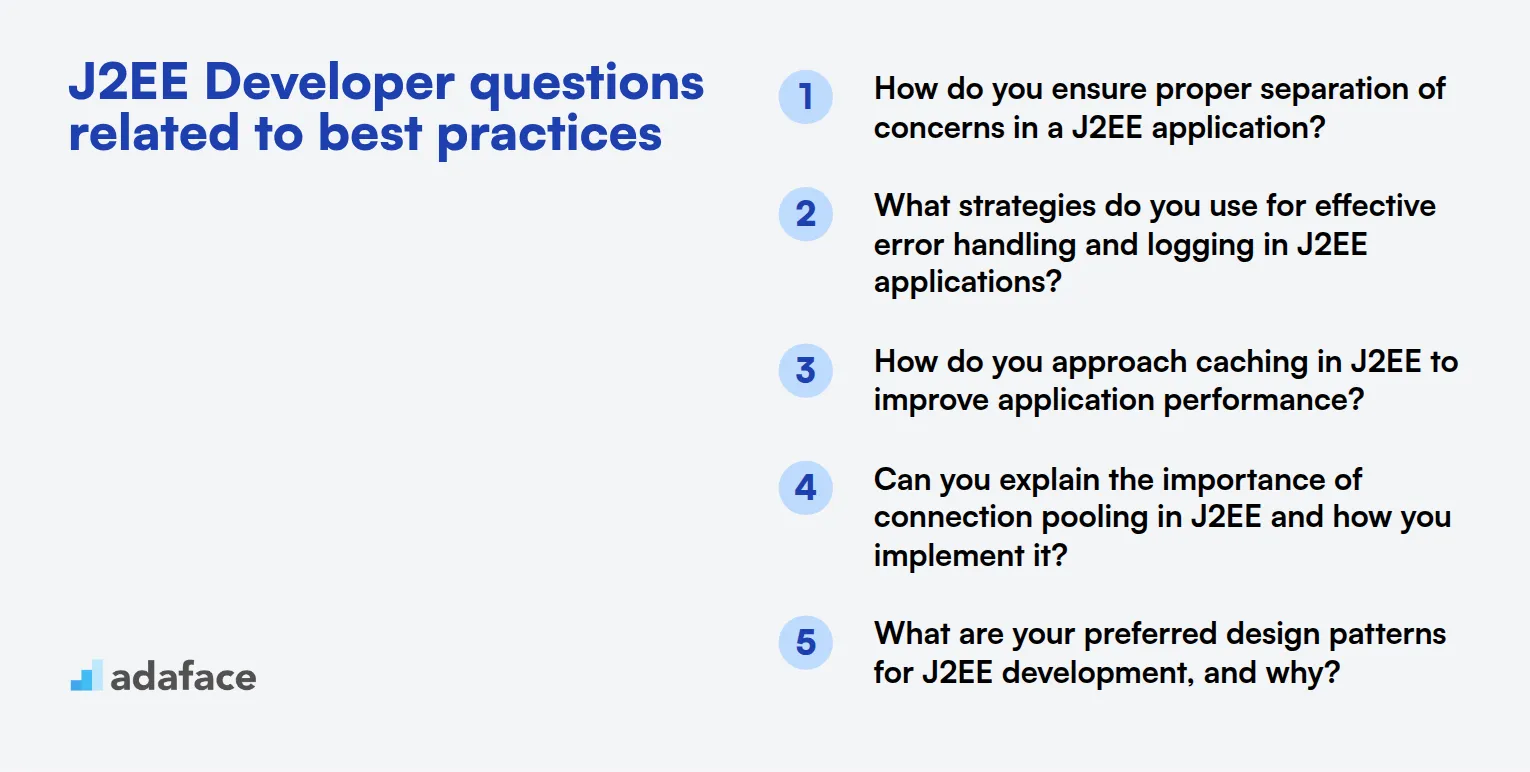
To assess a candidate's understanding of J2EE best practices and their ability to apply them in real-world scenarios, consider using these 12 interview questions. These questions will help you evaluate the applicant's expertise in implementing efficient, scalable, and maintainable J2EE solutions.
- How do you ensure proper separation of concerns in a J2EE application?
- What strategies do you use for effective error handling and logging in J2EE applications?
- How do you approach caching in J2EE to improve application performance?
- Can you explain the importance of connection pooling in J2EE and how you implement it?
- What are your preferred design patterns for J2EE development, and why?
- How do you ensure backward compatibility when upgrading J2EE components?
- What techniques do you use for optimizing database queries in J2EE applications?
- How do you implement asynchronous processing in J2EE to improve responsiveness?
- Can you describe your approach to writing unit tests for J2EE components?
- How do you handle concurrency issues in J2EE applications?
- What strategies do you employ for effective memory management in J2EE?
- How do you ensure proper configuration management across different environments in J2EE projects?
10 situational J2EE Developer interview questions for hiring top developers
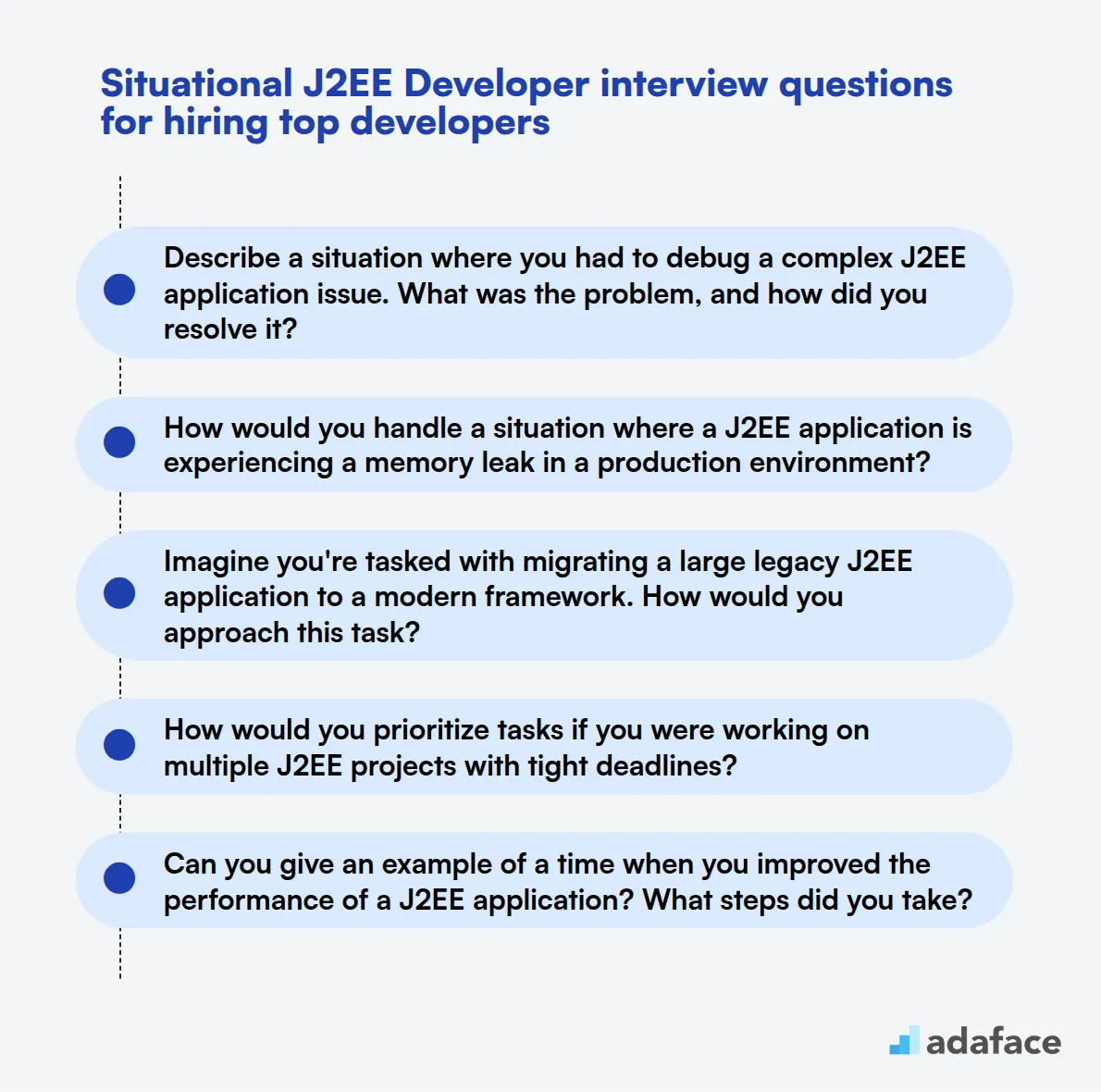
To identify top-tier candidates for your J2EE developer position, use these situational interview questions to gauge their problem-solving abilities and real-world experience. These questions help assess how well candidates can apply their knowledge to practical scenarios, ensuring you hire someone who can tackle the challenges of your projects effectively.
- Describe a situation where you had to debug a complex J2EE application issue. What was the problem, and how did you resolve it?
- How would you handle a situation where a J2EE application is experiencing a memory leak in a production environment?
- Imagine you're tasked with migrating a large legacy J2EE application to a modern framework. How would you approach this task?
- How would you prioritize tasks if you were working on multiple J2EE projects with tight deadlines?
- Can you give an example of a time when you improved the performance of a J2EE application? What steps did you take?
- Suppose you join a team that has a J2EE application with little documentation. How would you go about understanding the application architecture?
- How would you handle a scenario where a critical security vulnerability is discovered in your J2EE application?
- Describe a time when you had to integrate a third-party API with a J2EE application. What challenges did you face, and how did you overcome them?
- What would you do if you inherited a J2EE application built with outdated technologies that needed new features?
- How would you ensure that a J2EE application you developed can be easily scaled to handle increased traffic?
Which J2EE Developer skills should you evaluate during the interview phase?
While it's challenging to assess every aspect of a candidate's abilities in a single interview, focusing on core J2EE Developer skills is crucial. These key competencies form the foundation for success in the role.
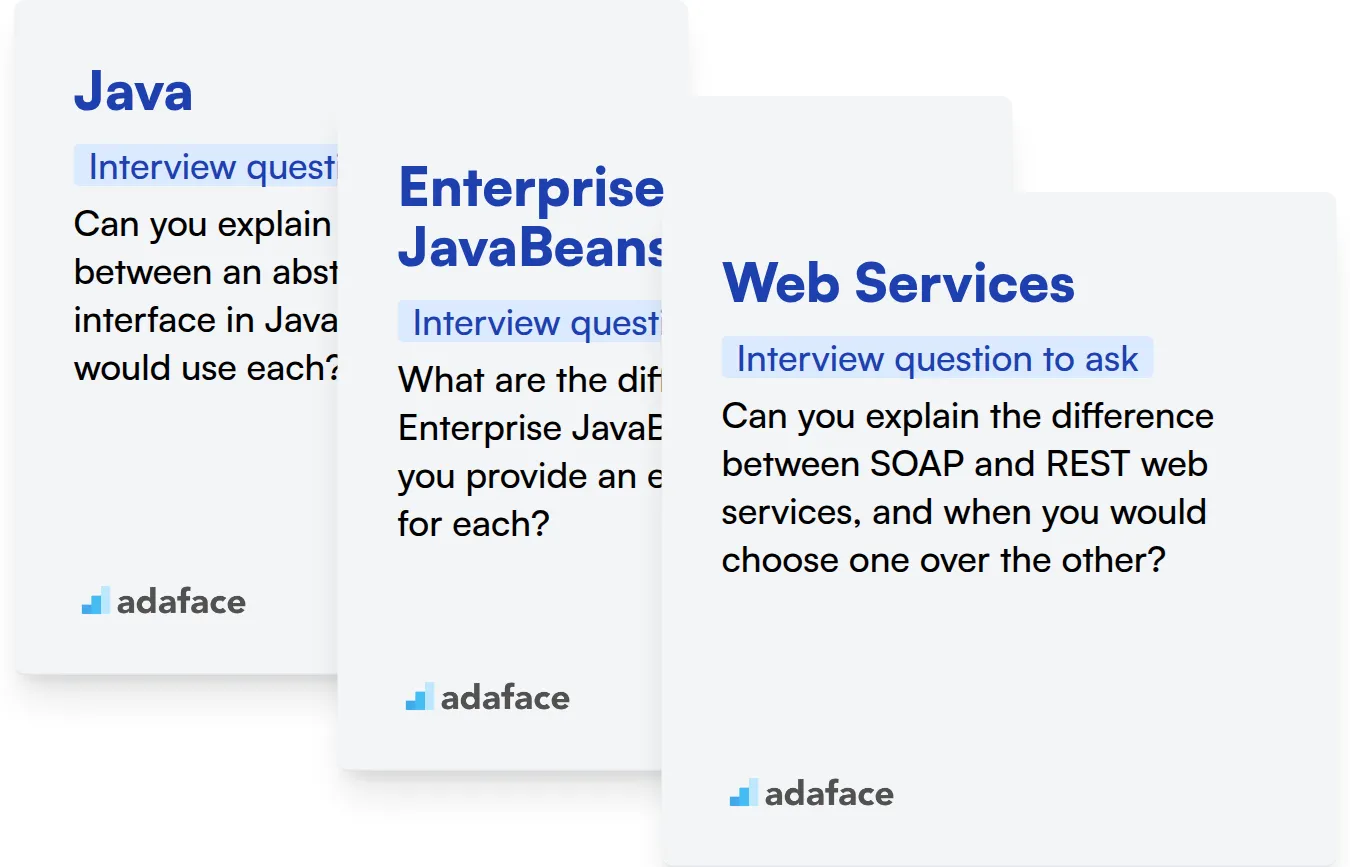
Java
Java is the cornerstone of J2EE development. A strong grasp of Java fundamentals, including object-oriented programming concepts, is essential for building robust enterprise applications.
Consider using an assessment test with relevant MCQs to evaluate candidates' Java proficiency. This can help filter out candidates with the required Java skills efficiently.
To assess Java skills during the interview, you can ask targeted questions. Here's an example:
Can you explain the difference between an abstract class and an interface in Java, and when you would use each?
Look for answers that demonstrate understanding of abstraction, multiple inheritance limitations, and practical use cases for both abstract classes and interfaces in Java.
Enterprise JavaBeans (EJB)
EJB is a key component of J2EE architecture. Proficiency in EJB allows developers to create scalable and distributed server-side components for enterprise applications.
An EJB-focused assessment can help evaluate candidates' knowledge of this critical J2EE technology.
To gauge a candidate's EJB expertise, consider asking:
What are the different types of Enterprise JavaBeans, and can you provide an example use case for each?
Listen for explanations of Session Beans (Stateless and Stateful) and Message-Driven Beans, along with appropriate scenarios for their use in enterprise applications.
Web Services
Understanding web services is vital for J2EE developers. This skill enables the creation of interoperable systems and integration with external services, which is common in enterprise environments.
Consider using a comprehensive J2EE assessment that includes questions on web services to evaluate candidates' knowledge in this area.
To assess web services knowledge, you might ask:
Can you explain the difference between SOAP and REST web services, and when you would choose one over the other?
Look for answers that demonstrate understanding of both protocols, their strengths and weaknesses, and scenarios where each would be more appropriate in a J2EE context.
Hire Exceptional J2EE Developers with Tailored Skill Tests
When looking to hire a J2EE Developer, it's important to ensure they have the necessary skills for the role. Assessing their knowledge accurately is key to making a good hiring decision.
The most effective way to verify these skills is by using specialized skill tests. Consider using our Java Online Test or EJB Online Test to evaluate candidates thoroughly.
After administering these tests, you'll be able to shortlist the best applicants based on their scores. You can then invite the top performers for a detailed interview.
To move forward with this process, you can visit our Adaface Signup Page or explore more on our Online Assessment Platform to get started.
Java Online Test
Download J2EE Developer interview questions template in multiple formats
J2EE Developer Interview Questions FAQs
Focus on general J2EE knowledge, enterprise application experience, best practices, and situational problem-solving skills.
Ask questions about core concepts, basic coding practices, and their willingness to learn and adapt to new technologies.
Look for expertise in enterprise applications, design patterns, performance optimization, and system architecture.
Use situational questions that present real-world scenarios and assess their approach to solving complex issues.

40 min skill tests.
No trick questions.
Accurate shortlisting.
We make it easy for you to find the best candidates in your pipeline with a 40 min skills test.
Try for freeRelated posts
Free resources




